|
THE DEVELOPMENT OF THE PRIAMURSKY TERRITORY BY
RUSSIA
The documents and photos dated from the second half
of the XIXth - the beginning of the XXth centuries introduce the
visitors the history of joining the Far Eastern territories to the
Russian Empire and their settling by Slavs from southern and central
provinces of Russia. The museum reconstruction of houses and offices
of the main social groups of migrants Cossacks, peasants, merchants
and intellectuals is of great interest.
Namely Cossacks - the military-service class - became
the first hunters, craftsmen and builders. Being the first frontier
guards in this territory they steadily protected the Far Eastern frontiers
of Russia.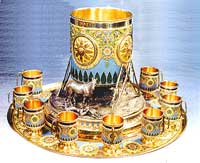 The unique exhibit - a wine-set is of great art and scientific value.
It symbolizes friendship and brotherhood of Cossacks. A wine-bowl and
wine-cups were made of silver in the technique of colour enamel in the
jewelry factory of brothers Khlebnikovs' by the order of the Cossacks
chieftain Pechonkin who was the commander of the Amur Cossack army.
The unique exhibit - a wine-set is of great art and scientific value.
It symbolizes friendship and brotherhood of Cossacks. A wine-bowl and
wine-cups were made of silver in the technique of colour enamel in the
jewelry factory of brothers Khlebnikovs' by the order of the Cossacks
chieftain Pechonkin who was the commander of the Amur Cossack army.
In the middle of the XIXth century the state borders of Russia were
legalized. In order to protect the eastern frontiers the governor-general
of Eastern Siberia N.N. Muravyov organized the first attempts to
raft down the Amur river which made for the systematic colonization
of Priamurye.
On the 28 of May 1858 in the Manchgurian town Aigun
the treaty was signed between Russia and China. According to that document
the left bank of the Amur river belonged to R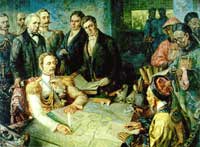 ussia.
After the Priamursky territories had joined the Russian Empire N.N.
Muravyov got a count title with addition to his name Amursky. A picture
of the Khabarovsk artist V.E. Romanov "The Aigun treaty" is
devoted to this historical event where the moment of the signing of
that agreement is shown. In 1860 the Peking treaty was signed. It finally
fixed the Russian Far Eastern territories in their present boundaries.
One can see the texts of the treaties in the museum exposition. ussia.
After the Priamursky territories had joined the Russian Empire N.N.
Muravyov got a count title with addition to his name Amursky. A picture
of the Khabarovsk artist V.E. Romanov "The Aigun treaty" is
devoted to this historical event where the moment of the signing of
that agreement is shown. In 1860 the Peking treaty was signed. It finally
fixed the Russian Far Eastern territories in their present boundaries.
One can see the texts of the treaties in the museum exposition.
The borders of the Priamursky Territory which was established
in 1884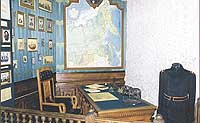 with the centre in Khabarovka are shown on the map of Eastern Siberia
in the interior "The study of the official of the Priamursky general-governorship".
Photos and documents inform the visitors how that vast Territory was
opened up and ruled by governor-generals. They were educated people,
patriots of their country who realized the big significance of the Far
Eastern territories for Russia.
with the centre in Khabarovka are shown on the map of Eastern Siberia
in the interior "The study of the official of the Priamursky general-governorship".
Photos and documents inform the visitors how that vast Territory was
opened up and ruled by governor-generals. They were educated people,
patriots of their country who realized the big significance of the Far
Eastern territories for Russia.
After Cossacks peasants from different provinces of
Russia migrated to the Far East. Due to Stolypin's reform peasants began
to come to the Far East very actively. Significant difficulties, diseases,
death were the constant concomitants of those people who ventured to
search a new life in the distant borders of the country. "A peasant
house" introduces the visitors some domestic appliances. They are
a 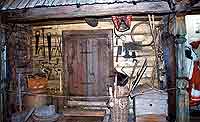 hand
spinning-wheel with a comb, a treadle spinning-wheel, a weaver's loom,
cast-iron pots, clay vessels for groats. There are also national clothes
of Russian, Ukrainian, Belorussian migrants (women's and men's shirts,
panyovy-skirts) and embroidered towels here. Not less interesting are
the agricultural implements (the late XIXth the early XXth centuries)
which are exposed near the fragment of a granary - ploughs, axes, a
flail, horse- gears. hand
spinning-wheel with a comb, a treadle spinning-wheel, a weaver's loom,
cast-iron pots, clay vessels for groats. There are also national clothes
of Russian, Ukrainian, Belorussian migrants (women's and men's shirts,
panyovy-skirts) and embroidered towels here. Not less interesting are
the agricultural implements (the late XIXth the early XXth centuries)
which are exposed near the fragment of a granary - ploughs, axes, a
flail, horse- gears.
In the stream of migrants there were not only peasants
but also workmen, handicraftsmen and merchants who made the first capital
out of furs, fish and barter with aborigines. Merchants began to trade
in the northern areas of the Territory with hunters, fishermen and reindeerbreeders.
Soon in addition to delivery and sale some tradesmen wanted to produce
goods and to start their own business. Exposed portraits of the famous
Khabarovsk merchants Plyusnins', Bogdanovs', Pyankovs', Tiphontay, Khmelevtsov,
Toporkov and others, banknotes of that time, a counting frame (abacus),
steelyards, advertisement booklets help to feel the epoch of free enterprise
in the beginning of the XXth century in Khabarovsk. 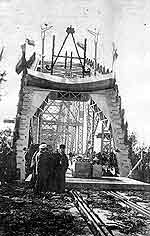 The
building of the Amur and the Ussuri sections of the Transsiberian main
line became the famous historical event and was finished by opening
of the Amur bridge which was built in 1913 - 1916 according to the project
of L.D. Proskuryakov and G.P. Peredery. The big section of the exposition
is devoted to the orthodoxy which was an integral part of culture of
the Slavs-migrants in the Russian Far East. The home-icons where Mary
the Virgin and the Lord-the Most High are portrayed, the icons of orthodox
holiday and church attributes (crosses, wedding crowns, a thurible,
a chalice, a ceremonial vestment of priests) are of great interest. The
building of the Amur and the Ussuri sections of the Transsiberian main
line became the famous historical event and was finished by opening
of the Amur bridge which was built in 1913 - 1916 according to the project
of L.D. Proskuryakov and G.P. Peredery. The big section of the exposition
is devoted to the orthodoxy which was an integral part of culture of
the Slavs-migrants in the Russian Far East. The home-icons where Mary
the Virgin and the Lord-the Most High are portrayed, the icons of orthodox
holiday and church attributes (crosses, wedding crowns, a thurible,
a chalice, a ceremonial vestment of priests) are of great interest.
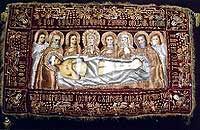 The
unique exhibit- the so called shroud of Christ -is a part of Easter
ceremony. It is a symbol of crucified Christ who was wrapped in it.
Historical photos narrate about the first educational and medical institutions
in the Far East, about the first printed publications of the Priamursky
department of the Imperial Geographical Society, about the first newspapers
"Priamurskiye vedomosty" and "Priamurskaya zhisn".
In the interior of the flat of the intellectual there are a writing-desk The
unique exhibit- the so called shroud of Christ -is a part of Easter
ceremony. It is a symbol of crucified Christ who was wrapped in it.
Historical photos narrate about the first educational and medical institutions
in the Far East, about the first printed publications of the Priamursky
department of the Imperial Geographical Society, about the first newspapers
"Priamurskiye vedomosty" and "Priamurskaya zhisn".
In the interior of the flat of the intellectual there are a writing-desk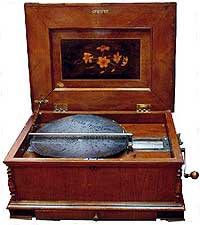 ,
a musical instrument and a dress of a petty bourgeois woman. On display
one can also see a collection of women's bags, a suit, a hat and a cane. ,
a musical instrument and a dress of a petty bourgeois woman. On display
one can also see a collection of women's bags, a suit, a hat and a cane.
A wonderful exhibit - a music box made in Switzerland at the end of
the XIXth century attracts visitors' attention. On the metal plates
there are some popular melodies of that time. The visitors have the
unique opportunity to hear polkas, waltzes, marches, mazurkas and to
be carried away in their thoughts into for ever gone epoch when our
forefathers felt happy and sad, loving and laughing.
|





